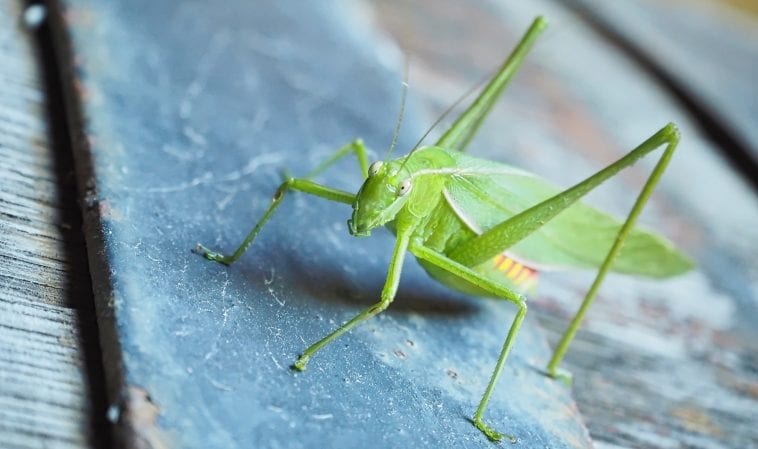[Thanks to Karl Priest for first sharing this article on his Insects Page]
Today we’re going to do a study through a long and information-packed article in Scientific American: Awesome Ears: The Weird World of Insect Hearing by Stephanie Pain
The subhead starts us right off with the author’s worldview:
Evolution made insect ears many times over, resulting in a dazzling variety of forms found in spots all over the body.
But it then moves on to the fascinating world of modern scientists and the living creatures they study. Interestingly, the katydid they focus on here and again at the end of the article has ears that are “uncannily” like ours, even though these evolutionists assume all organisms developed from a single common ancestor.
Perhaps instead we should consider the reality that both the katydid and humans have a common Designer.
After an interesting foray into the ability of an Australian katydid to lure their cicada prey with their music, the article turns back to its main purpose, complete with hyperlink to make sure you delve even more deeply into it:
Evolution has made so many attempts at shaping ears, the result is a huge diversity of structures and mechanisms.
The general list that follows is real world information, but the author can’t go more than two sentences before getting back to her siren song:
Sensory biologists, acoustics experts and geneticists are working together to pin down how they all work, how and when they evolved, and why.
They can work together, but they are going to be stuck trying to study how they evolved for a long, long time. As for “why,” how can there possibly be any kind of real answer to this question when you assume a mindless, purposeless process is behind everything?
It is interesting to see how heavily today’s biologists rely on the assumptions of the paleontologists. And these in turn look to the specialists in radiometric dating. The rocks are real, the bugs encased in them are real. The timeline and family trees based on assumptions about them exist only in the minds of the evolutionists.
When insects first appeared some 400 million years ago, they were deaf, Göpfert tells me. These ancestral insects went on to diversify into more than 900,000 species, and while most remain as deaf as their ancestors, some gained the means to hear.
While he doesn’t tell us the reason for his confidence, it would make sense that this gentleman’s belief that insects started out without hearing apparatus developed because the deepest fossils we find are of insects whose living descendants are deaf today.
Hmm, 400 million years. Living descendants so similar scientists are confident the ancient ones didn’t have hearing because the modern ones don’t?
All told, insect ears arose more than 20 separate times, a sure-fire recipe for variety.
Really? What we know from the world around us is that at least 20 different groups of insects—ones that no one thinks developed from each other—can hear. The word “arose” itself is a sheer magic word. No mechanism is given here, just the vaguest verbiage possible.
Next, we get a fun and mind-bending list of the array of places various insects have their ears. The author managed to go a whole paragraph without mentioning evolution, but that only gives her more oomph for her conclusion that each location is ideal for a mindless, purposeless process to take advantage of:
In every case where an insect ear evolved, the starting point was an existing sensory organ: a stretch detector that monitors tiny vibrations when neighboring body segments move.
If only evolutionists could see that this is exactly what happened, only the decision to add hearing to the sensations these detectors monitors was made by a brilliant designer.
From there on, each new attempt to forge ears went even further in its own direction as other structures were co-opted and reconfigured to capture, amplify and filter sound, extract the relevant information and convey it to the nervous system.
Yes, they were, but not by a mindless, purposeless process that had only random mutations to work with while slowly developing new features over millions of years.
Amazingly, the article returns to an exciting list of various examples of real-world insect hearing equipment for quite a while. It’s taken the scientific community a long time to even learn about these abilities because of things like this:
Katydid ears, as so neatly demonstrated by Montealegre-Z and his colleagues, are unique both in their complexity and their similarity to a mammal’s. Using a micro-CT scanner, the scientists reconstructed the insect’s entire hearing system,
If it takes a highly advanced piece of equipment to even figure out what’s going on with this bug, what does it say about the abilities that built this organ in the first place?
Katydids solved the problem (again, in a unique way) by enlarging a breathing tube…
Ahh, here we get the real thinking of the evolutionist: the living world is itself the intelligent designer.
- The bug had a problem,
- recognized its need,
- found a piece of equipment that mindless, purposeless chance had provided,
- and used their copious intellect to come up with an elegant solution.
So, naturally, according to this author and others the katydid deserves the credit for coming up with its own body plan and abilities.
The Evolutionists’ Favorite Song
Verse: “But what drove evolution to turn stretch receptors into ears in the first place, and so bring sound to the insect world? That’s a question still on many entomologists’ minds…”
Chorus: “One thing’s certain: As biologists investigate more insect groups in greater detail, some long-held notions may bite the dust.”
You can take almost any article introducing a new finding in biology and you’ll hear this same tune at the end: they still have lots of questions and expect lots of upsets. I’m actually surprised this one didn’t close with the happy thought that we will surely unravel the secrets of the universe eventually if we keep at this search long enough. But, for this author, just learning more about the existing insects is enough to add a major note to her thinking. I agree it is indeed a worthy and satisfying study.
The rest of the article is filled with more review of the actual fossils of katydids—that were already katydids when they got turned to stone—and the guesses of the scientists about what they used their sound-making and listening equipment for in the past.
This piece is well worth reading for its information, but wouldn’t it be better for us and our children to give the credit for these fabulous creatures where it is due?
He that hath ears to hear, let him hear. Mark 4:9
Make a joyful noise unto the LORD, all the earth: make a loud noise, and rejoice, and sing praise. Psalm 98:4







